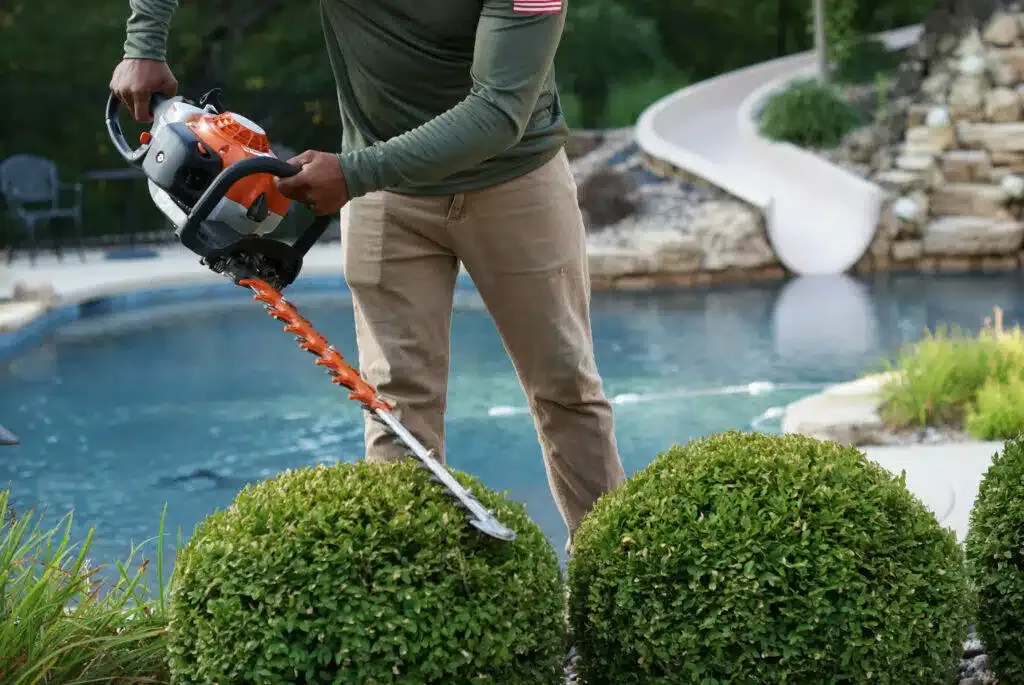Provide your green landscape with the healthiest and heartiest lifespan by following these essential pruning tips from our expert!


Proper pruning and maintenance can seem quite daunting for most homeowners. To many, the art of pruning is mysterious and misunderstood. However, pruning may be one of the most critical maintenance tasks next to watering. In general, pruning is the removal of part of a plant, living or dead, for the benefit of the plant as a whole. This crucial task does not need to be anxiety-inducing! We’ve put together essential steps to help elevate your trees’ lifespan. We promise it’ll take the worry out of this simple but necessary maintenance technique. Find out more information on pruning evergreens!
Tip 1: Best Tools for Pruning




As with all pruning, these proper tools and tips are essential for success!
✅ A sharp, sturdy pair of bypass pruners and a saw that cuts when pulled are the best tools when pruning plants and trees.
✅ Torn or jagged cuts will not heal properly and leave the area exposed to disease and decay. Good pruning cuts should be made just to the branch bark ridge (the space between the tree trunk and the point where the branch originates from the trunk).
✅ Stubs left behind by improper pruning cuts will eventually rot and spread rot to the main trunk of the tree.
✅ It is best practice to sanitize your pruning tools after each use to prevent the disease from spreading from one tree to another.
Tip 2: Prune Away Diseased or Dying Branches




If it isn’t showing a form of life or is discolored or filled with holes, it’s time to make some cuts!
✅ The priority is to remove diseased, dying, or dead branches. This is key to preventing the spread of disease to other branches or trees nearby.
✅ Many flowering trees will produce two types of full unwanted shoots from latent buds, which can quickly overpower a tree and rob it of vital nutrients.
- WATER SPROUTS: Their upright growth habit can identify latent buds that develop on the trunk or lateral branches. These should be removed at the point of origin.
- SUCKERS: Latent buds that develop from the roots. These are equally detrimental to the health and vigor of the tree, and they should be removed at or below ground level.
Tip 3: Prune Away Weak Branches or Competing Branches


✅ Trees that are not or have not been pruned regularly can often develop branches that compete or rub against each other. These branches should be removed to prevent other branches from being damaged or dying back.
✅ Trees that haven’t been appropriately pruned can develop weak or narrow crotches.
- The crotch of a tree is any place where two branches come together to form a “v” shape. A 30 to 70-degree wide crotch should be promoted if possible, for a weak crotch can result in severe to catastrophic damage during high winds or heavy snows.
Tip 4: Improve Air Circulation with Pruning


✅ Careful and selective removal of branches in a mature tree’s crown will allow for greater light and air penetration lower in the canopy.
✅ Many insects and diseases can thrive in stagnant environments. Improving air circulation through a tree’s crown can prevent many of these issues without spraying insecticides or fungicides.
✅ If insects or diseases become an issue, a more open crown will allow for greater spray penetration.
✅ Flower and fruit development are directly affected by air and light penetration – without adequate air and light, flowering and fruit production will be significantly diminished.
Tip 5: Pruning Shape and Size


✅ Correct pruning is essential in maintaining a plant’s size and form, but the proper selection is equally important.
- Pruning too thin will reduce a tree’s density but will have little to no effect on its overall size.
- Selecting a tree that will mature into the space is far more desirable than attempting to maintain a tree’s size.
- Without reduction pruning, a tree can quickly outgrow its space.
✅ It is vital to be familiar with a tree’s natural form to prune and promote an appropriate and natural shape.
✅ Prune during the winter to develop a tree’s structure, but be careful not to over-prune during the dormant period.
- Over-pruning can result in excessive spring growth, ultimately needing additional work.
✅ Summer is a great time to control a tree’s shape and size; it will aid with inhibiting overall growth.
Meet Our Maintenance Team






Elevate Outdoor cares significantly about the maintenance and care of your lawn and landscape. We offer various services from Fall clean up to mowing to weeding and trimming! It is a great honor to serve our customers, and we work hard to ensure you’re satisfied. So contact our customer service department or fill out a free quote form, and let the experts make your outdoor landscape shine!









